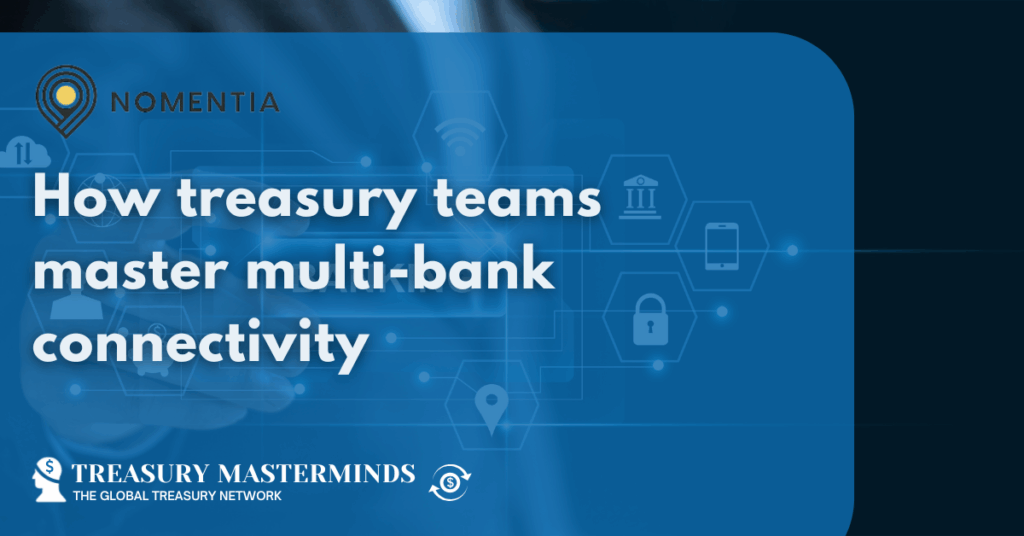
How treasury teams master multi-bank connectivity
This article is written by Nomentia What is multi-bank connectivity? Multi-bank connectivity allows treasury teams to manage cash positions and payments across several banks and ERPs from one central platform. Instead of logging into multiple portals and reconciling spreadsheets, treasurers gain real-time visibility, standardized workflows, and stronger controls. This reduces risk, prevents errors, and ensures compliance—making it a core capability for mid-market and enterprise companies operating internationally. With the proper connectivity, treasurers gain real-time visibility across all banks and entities in one place. Instead of chasing spreadsheets and portals, they can focus on optimizing liquidity and supporting important business decisions. Why multi-bank connectivity is the missing link in modern treasury If your treasury team is still juggling multiple bank portals, scattered ERP connections, and endless spreadsheets, you’re not just wasting time—you’re leaving your company exposed. A single missed cut-off or duplicate payment can lock up millions in working capital, while delayed cash visibility may force the business to borrow unnecessarily or miss an investment opportunity. Payment operations and cash visibility determine whether salaries are paid on time, suppliers are settled without delays, and the company has the liquidity to fund daily operations and strategic investments. And yet, many treasury managers spend hours every day piecing together fragmented data instead of making decisions that move the business forward. For mid-market multinationals, the complexity is ever-present. You may run a subsidiary in France, another in the Nordics, a shared service center in Eastern Europe, while you yourself are sitting in a mid-sized German town. Suddenly, you’re managing connectivity not only across borders and jurisdictions, but also across time zones and conflicting bank cut-off times. You might have arrived at this situation in different ways: through acquisitions that left you with multiple ERPs, by expanding into new markets with local banking partners, or by building a patchwork of systems over time. In the end, the origin doesn’t matter—the reality is that complexity won’t resolve itself. It will only get harder to manage until treasury takes deliberate action to centralize and regain control.. Without centralized connectivity, treasury teams can’t answer the most basic questions with confidence: “How much liquidity do we actually have today?” or “Can we trust that all payments are executed correctly and on time?” The result: sleepless nights, manual workarounds, and a constant risk of errors or fraud. Multi-bank connectivity is not a “nice-to-have.” It’s the foundation for running treasury with control, confidence, and credibility. Real-life treasury scenario: the struggles of multi-bank connectivity Let’s step into the shoes of Maureen, a Group Treasurer at a €700M German manufacturing company. Her mandate from the CFO is clear: ensure liquidity, keep payments under control, and prevent surprises. But here’s her reality: On Monday morning, she faces the same questions: The truth? Maureen doesn’t have the answers at her fingertips. Instead, she spends hours coordinating with colleagues, chasing down reports from different subsidiaries, and piecing together siloed updates over email. Even once she gathers CSV files from portals and pastes data into Excel, she’s still playing catch-up—and by the time a liquidity update reaches the CFO, the numbers are already outdated. It’s not that Maureen lacks expertise—she knows treasury inside out. The problem is that her processes are fragmented by design. And because visibility and control are scattered, she’s left exposed to risks she can’t fully manage: Maureen’s story is fictional, but every treasury manager working in a multi-bank, multi-ERP environment will recognize themselves in it. Key challenges of multi-bank cash and treasury management Managing liquidity across several banks and ERPs may sound straightforward on paper. In practice, it quickly becomes a daily obstacle course. Treasury teams are expected to deliver reliable insights and oversight, yet fragmented processes often make that impossible. In an ideal world, Maureen would log into a single platform each morning, see consolidated balances across all banks and entities, and share a reliable update with the CFO in minutes. Instead, she spends hours chasing data and reconciling mismatched reports to build a partial view. The biggest challenges in multi-bank payment operations Cash visibility is only one side of the equation. The other is ensuring that payments flow smoothly, securely, and on time across multiple banking partners. Multiple banks mean multiple formats and portals Every bank still has its own formats and processes. While industry standards have helped, they haven’t removed the complexity—leaving treasury teams dependent on a solution that can harmonize these differences automatically. Manual reconciliation and compliance risks grow with scale The irony? Treasurers are tasked with reducing risk, but fragmented bank processes create new ones. The role of bank connections Companies don’t work with multiple banks by accident. They do so for: But these benefits come with operational trade-offs. Complexity, cost, and overhead Every new bank adds unique formats, portals, and maintenance requirements. Instead of increasing control, it creates silos. Why Seamless Connectivity Is Essential Treasury needs a platform that delivers: Without this, the benefits of multi-banking are lost in inefficiency. With it, diversification becomes a strategic strength. Why multiple ERPs complicate multi-bank payments and cash visibility Many companies also run multiple ERPs, often due to M&A or regional legacy systems. For treasury, this creates: Treasury’s mandate is to provide accurate liquidity insights. That requires independence from ERPs — and the ability to unify data across them. What treasury teams really need from multi-bank connectivity Treasury’s requirements can be summarized into four essentials: A Quick Snapshot With manual connectivity With holistic connectivity Cash Visibility Fragmented, outdated Real-time, consolidated Payment Execution Multiple portals, manual uploads Centralized, automated Fraud Prevention Manual, inconsistent Built-in, standardized Forecasting Excel-driven, error-prone Integrated, reliable Multi-bank connectivity equips treasurers with the control, confidence, and credibility they need to meet rising expectations. How modern multi-bank connectivity solutions solve treasury challenges Nomentia approaches these challenges by focusing on simplifying connectivity and standardizing processes without adding unnecessary complexity for treasury teams. Instead of treasurers having to manage multiple portals, formats, or integration projects themselves, Nomentia provides a central hub that connects to banks through established channels such as SWIFT, EBICS, APIs, or host-to-host links….

Verification of Payee Is Live — But What Really Changed? With real life examples.
From Treasury Masterminds After years of regulatory buildup, Verification of Payee (VoP) officially went live across Europe on October 9th, 2025. For some, this marks a major step forward in fraud prevention and payment integrity. For others, it feels like business as usual — with little visible change.As often happens in treasury, the truth lies somewhere in between. This article looks at what’s actually happened since go-live — the early real-world cases, the operational impacts, and what treasurers should keep an eye on. A Quick Reminder: What VoP Is Meant to Do VoP verifies whether the name and IBAN combination entered before a payment is consistent with the official records held by the bank.The goal is to reduce fraud, misdirected payments, and typing errors — an extra safeguard before funds move. In theory, this should be straightforward.In practice, it’s exposing how inconsistent master data and banking records really are. Real Stories From the First Week 1. Tax Payments in Brandenburg Triggered False Mismatches In the German state of Brandenburg, many taxpayers received “name–IBAN mismatch” warnings when paying local tax offices. The problem wasn’t fraud — it was minor differences in how names were stored at the Bundesbank. Authorities later confirmed all accounts were valid, but the incident highlighted how even public institutions can fail VoP’s data precision test.Source: Tagesspiegel / Brandenburg Ministry of Finance, October 2025 2. Customers Hit by Formatting and Umlaut Issues Focus Online reported that almost one-third of users encountered warnings or rejections due to name format variations — missing umlauts, reversed order, abbreviations, or extra spaces.For corporates, this means supplier names like “Müller GmbH” versus “Mueller GmbH” can now trigger verification warnings.Source: Focus Online, October 2025 3. Batch Payments Slower to Process BNG Bank in the Netherlands confirmed that batch payments are now subject to VoP checks on each individual transaction. As a result, payment runs may take longer to complete — a relevant consideration for payroll or high-volume AP files.Source: BNG Bank client update, October 2025 4. Cross-Border Payments Show Gaps Rabobank noted that certain foreign IBANs currently return a “cannot be checked” message because some international accounts are not yet covered by VoP databases. Those payments proceed as before, but users need to accept or override the warning.Source: Rabobank business portal, October 2025 5. Mixed Feedback From Banks The Frankfurter Allgemeine Zeitung reported that banks generally described the rollout as “stable,” but several institutions have invited customer feedback to identify remaining friction points.Source: FAZ, October 2025 What’s Actually Changed for Treasurers The Treasury Takeaway VoP may not have revolutionized the way treasurers work — but it has quietly introduced new friction points that will affect daily operations.The infrastructure works, but the rollout is exposing long-standing issues around data standardisation, naming conventions, and bank integration. This isn’t a “no-news” event. It’s the start of a new phase of operational fine-tuning across treasury teams. Share Your Experience How is VoP affecting your payment processes?Did your first post–October 9th payment runs go smoothly, or did you face unexpected mismatches and delays? We’re gathering real-world stories from the Treasury Mastermind community — both wins and fails — to build a collective picture of how VoP is landing in practice. Share your experience or start a discussion in our community forum at www.treasurymastermind.com. Let’s turn individual experiences into shared learning for all treasurers navigating this new reality. Also Read Join our Treasury Community Treasury Mastermind is a community of professionals working in treasury management or those interested in learning more about various topics related to treasury management, including cash management, foreign exchange management, and payments. To register and connect with Treasury professionals, click [HERE] or fill out the form below to get more information. Notice: JavaScript is required for this content.